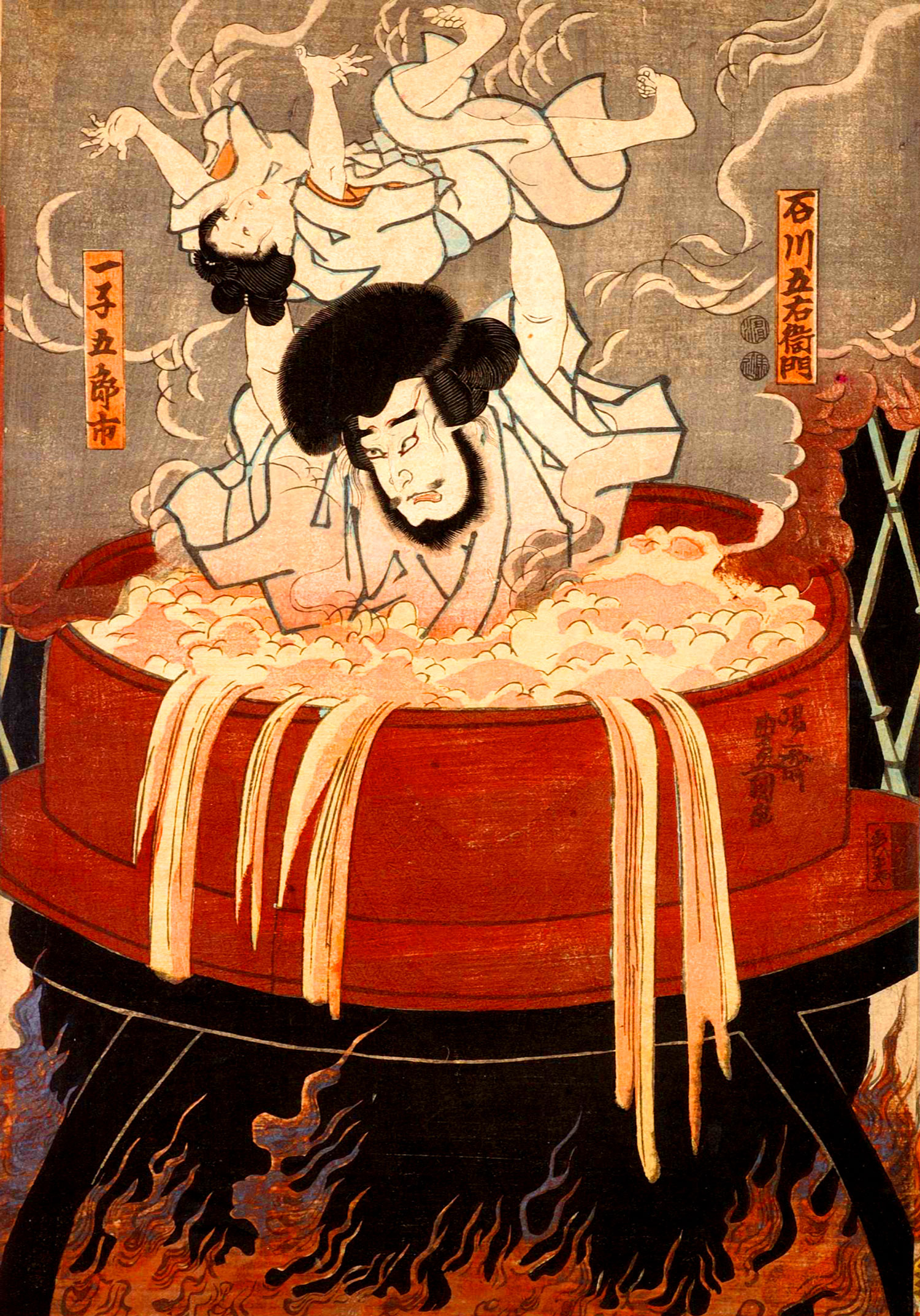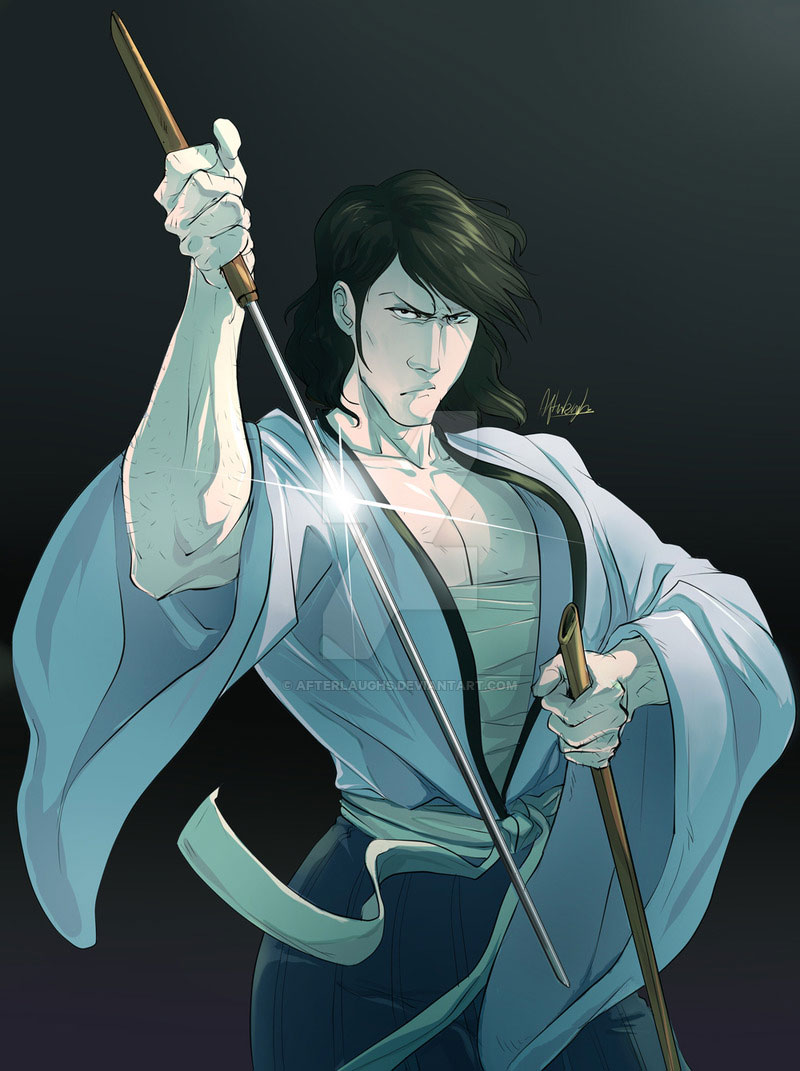Japan History: Ishikawa Goemon
Ishikawa Goemon

Photo credits: data.ukiyo-e.org
Ishikawa Goemon (石川 五右衛門, 1558 – 8 Ottobre, 1594) è stato un fuorilegge Giapponese semi leggendario che rubava oggetti di valore ai ricchi per darli ai poveri. Proprio per questa sua caratteristica viene a volte definito il Robin Hood del Giappone. Esistono molte storie che lo vedono protagonista e che lo descrivono come un eroe popolare che si batte contro i potenti per i più deboli. L’autenticità di queste storie tuttavia non è sempre certa.
La sua prima apparizione negli annali storici si ritrova nella biografia di Toyotomi Hideyoshi del 1642 che lo descriveva semplicemente come un ladro.
Ci sono varie versioni della vita di Ishikawa Goemon. Secondo una di queste, egli nacque come Sanada Kuranoshin nel 1558 da una famiglia di samurai al servizio del clan Miyoshi della provincia di Iga. Nel 1573, quando suo padre, presumibilmente Ishikawa Akashi, fu assassinato dagli uomini dello shogunato Ashikaga, il quindicenne Sanada giurò vendetta. Cominciò quindi ad allenarsi nelle arti del ninjutsu a Iga sotto Momochi Sandayu. Allievo abilissimo ma di temperamento irruento, fu costretto a scappare quando il suo maestro scoprì la relazione di Sanada con una delle sue amanti.
Altre fonti gli danno il nome di Gorokizu, la cui provenienza viene individuata nella Provincia di Kawachi e non era un nunekin (ninja fuggitivo). Si era poi spostato nella regione del Kansai dove formò e guidò una banda di ladri e banditi come Ishikawa Goemon. Con questa banda rubava ai ricchi signori feudali, mercanti e clericali, condividendo poi il bottino con i poveri.
Secondo un’altra versione, che gli ha anche attribuito un attentato a Oda Nobunaga, sembra sia stato obbligato a diventare un ladro quando la rete organizzativa dei ninja fu distrutta.
Ciò che è certo è che Ishikawa Gomen divenne presto un personaggio popolare e apprezzato dal popolo, e non mancano gli aneddoti sulle sue avventure. Si dice che una volta, entrato in una stanza per compiere un furto, venne distratto dal sorriso di un bambino. Ishikawa cominciò a giocare con lui perdendo così il momento per mettere a segno il colpo. Un’altra storia riguarda il suo tentativo di assassinare il grande generale Oda Nobunaga. Una volta entrato nell’edificio di Oda, si nascose nell’attico proprio sopra la camera da letto del generale. Quando questi si fu coricato, Ishikawa praticò un buco sul soffitto proprio in corrispondenza della testa di Oda. Dal buco calò un tubicino tenendolo sospeso sopra la bocca del daimyo, tramite il quale fece passare un potente veleno. Ma il sonno di Oda Nobunaga era leggero e, svegliatosi, riuscì a sventare in tempo l’attentato.

Photo credits: wikipedia.org
Versioni molto conflittuali riguardano anche la sua pubblica esecuzione nell’olio bollente davanti al cancello del tempio Buddhista Nanzen-ji a Kyoto.
Secondo una prima versione, alcuni compagni di scorribande di Goemon furono catturati e costretti a confessare il nome del loro capo.
Una seconda versione afferma invece che Goemon provò ad assassinare Toyotomi Hideyoshi. Alcuni dicono che lo fece per vendicare la morte di sua moglie Otaki e la cattura di suo figlio Gobei, altri perchè lo shogun era ritenuto un despota. Entrato nella camera di Hideyoshi, nel castello di Fushimi, fu però scoperto dalle guardie perché urtò un tavolo facendo cadere una campanella. A volte si parla invece di un bruciatore di incenso magico capace di emettere un suono di richiamo. Fu quindi catturato e condannato a morire, gettato vivo nell’olio bollente in un calderone di ferro, insieme al suo figlio più giovane.
Ma se Goemon incontrò così la sua fine, le storie divergono sul destino del figlioletto. In alcune, Goemon riuscì a salvarlo tenendolo in alto sopra la testa, e il figlio fu poi perdonato. In altre invece, si dice che il padre all’inizio provò a salvare il figlio tenendolo sopra la testa ma, resosi conto della futilità del suo gesto, lo spinse sul fondo del calderone per ucciderlo il prima possibile. Rimase poi con il corpo del bambino sollevato in alto in segno di scherno verso i suoi nemici, fino alla morte per il dolore e le ferite.
Anche la data della sua morte è incerta, alcuni dicono che avvenne in estate, mentre altri la datano l’8 Ottobre, quindi in autunno. Prima di morire, Goemon lasciò un poema d’addio nel quale diceva che qualunque cosa fosse successa, al mondo ci sarebbero sempre stati dei ladri.
Una pietra tombale dedicata a lui può essere visitata ancora oggi nel Tempio Daiunin a Kyoto, mentre le tradizionali vasche verticali giapponesi, solitamente di ferro o legno, prendono ancora oggi il nome di goemonburo (Vasca di Goemon)
Teatro Kabuki e Cultura Popolare

Photo credits: img00.deviantart.net
Ishikawa Goemon è il soggetto di molte rappresentazioni teatrali kabuki. Quella che ancora oggi viene messa in scena è Kinmon Gosan no Kiri (Il Portale d’Oro e lo Stemma di Paulonia). Consiste in cinque atti scritti da Namiki Gohei nel 1778, di cui il più famoso è quello intitolato Sanmon Gosan no Kiri (Il Portale Sanmon e lo Stemma di Paulonia). In questo atto Goemon è visto seduto in cima al portale Sanmon del tempio Nanzen-ji. Sta fumando una pipa d’argento molto grande chiamata kiseru ed esclama “La vista primaverile merita un migliaio di pezzi d’oro, o così dicono, ma è troppo poco, troppo poco. Agli occhi di Goemon ne vale diecimila!” Goemon presto capisce che suo padre, un cinese chiamato So Sokei, era stato ucciso da Mashiba Hisayoshi e comincia a preparare la sua vendetta.
Il suo personaggio appare anche nel famoso racconto Quarantasette Ronin, messo in scena per la prima volta nel 1778. Nel 1992 invece, Goemon appare nella serie kabuki di alcuni francobolli postali Giapponesi.
Nella cultura popolare moderna ci sono in generale due modi in cui Goemon viene rappresentato: un giovane, scaltro ninja, o un potente bandito Giapponese.
Goemon è il personaggio principale della serie di video games Konami Ganbare Goemon dalla quale è stata tratta una serie televisiva. È anche il personaggio principale dei romanzi Shinobi no Mono e della serie di film ad essi ispirati, interpretati da Ichikawa Raizō VIII nel ruolo di Goemon. Nel terzo film, Shin Shinobi no Mono, conosciuto in inglese come Goemon Will Never Die, il protagonista sfugge all’esecuzione mentre un altro uomo viene buttato al suo posto nell’olio bollente. Goemon è anche il protagonista di alcuni film Giapponesi girati prima della seconda guerra mondiale come Ishikawa Goemon Ichidaiki e Ishikawa Goemon no Hoji.
Più recentemente invece, nel film Goemon del 2009 è interpretato da Yōsuke Eguchi e viene descritto come il più fedele seguace di Nobunaga assieme a Hattori Hanzō.
Il personaggio di Goemon appare anche in numerosi altri videogame come nella serie Samurai Warriors, Warriors Orochi, Blood Warrior, Kessen III, Ninja Master’s: Haō Ninpō Chō, Shall We Date?: Ninja Love, Shogun Warriors, e Throne of Darkness. È anche una Persona iniziale in Persona 5 di Yusuke Kitagawa, e fa la sua comparsa anche nel drama taiga Hideyoshi, nel film Roppa no Ôkubo Hikozaemon, e nei manga Kaze ga Gotoku e Bobobo-bo Bo-bobo.
Ma forse il personaggio più conosciuto di tutti è quello di Ishikawa Goemon XIII in Lupin III (Rupan Sansei), diretto discendente del leggendario ladro e ideato dal mangaka Monkey Punch.
Share this:
- Click to share on Facebook (Opens in new window)
- Click to share on Twitter (Opens in new window)
- Click to share on Tumblr (Opens in new window)
- Click to share on Pinterest (Opens in new window)
- Click to share on Telegram (Opens in new window)
- Click to share on WhatsApp (Opens in new window)
- Click to share on Reddit (Opens in new window)
- Click to print (Opens in new window)






